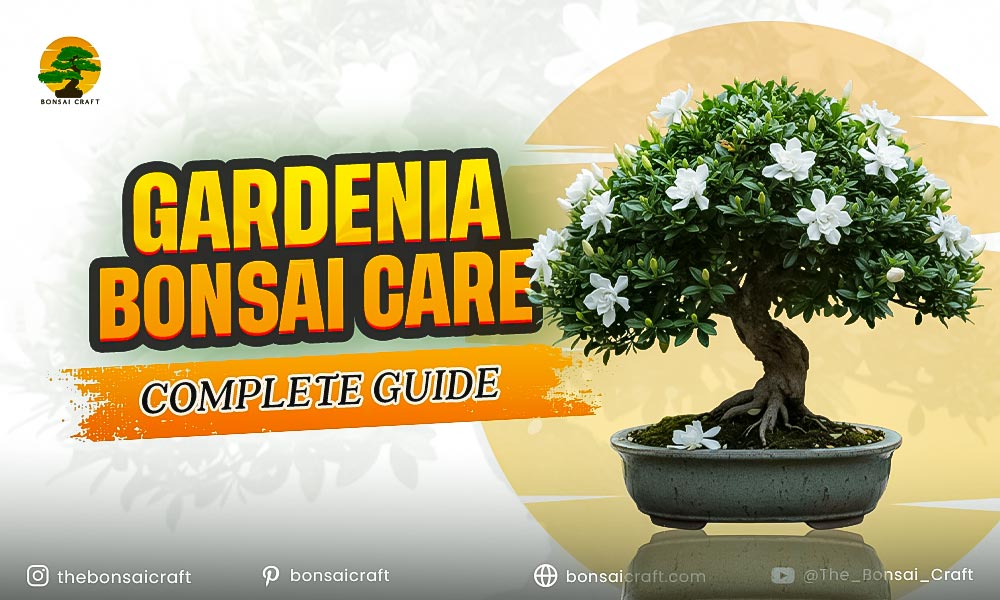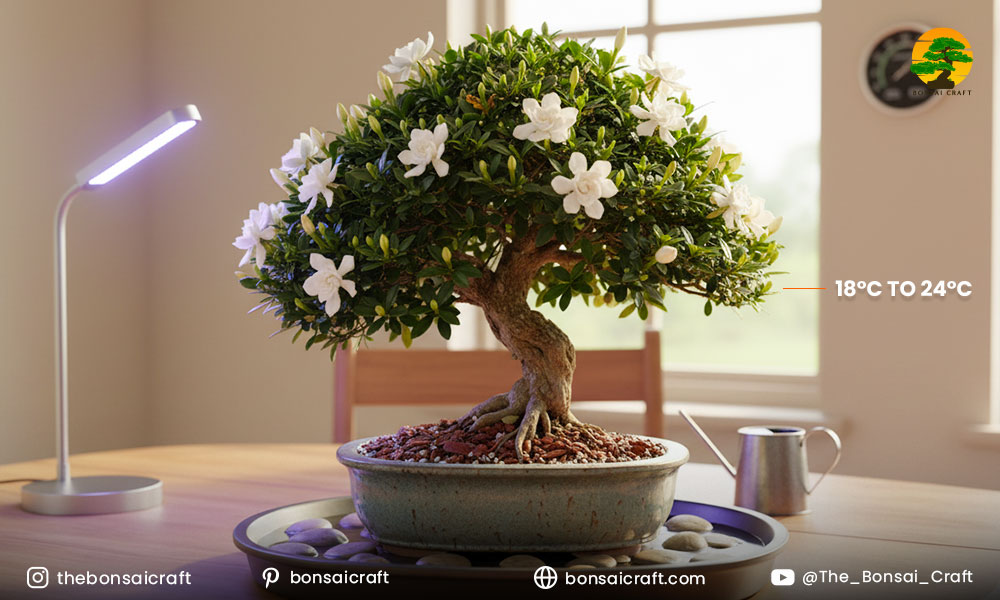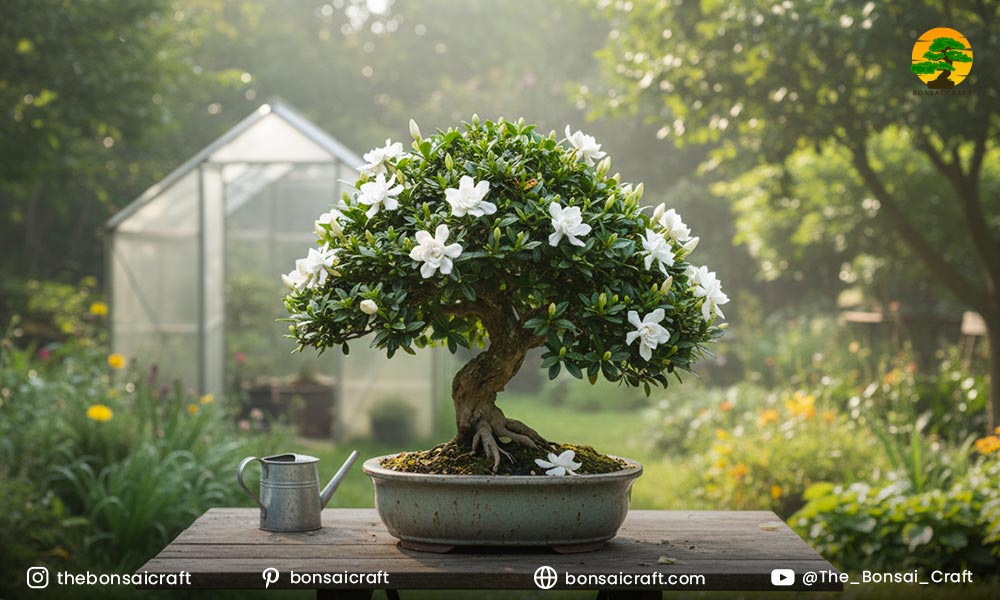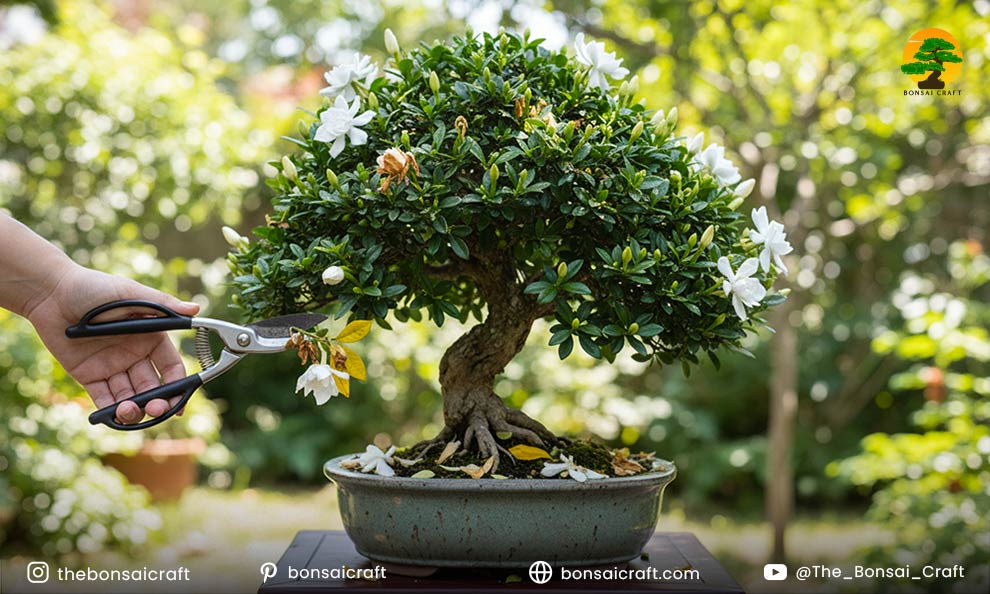
A gardenia bonsai is a stunning, fragrant, and visually appealing plant that adds both elegance and a sense of tranquility to any space. With its glossy leaves, beautiful white flowers, and aromatic fragrance, it’s no surprise that the bonsai gardenia has captured the hearts of bonsai enthusiasts. However, growing a gardenia bonsai requires specific care to ensure the plant thrives and continues to bloom year after year.
As a seasoned bonsai grower with years of experience cultivating various species, I can confidently say that a gardenia bonsai indoor care routine involves a balanced approach of the right environmental conditions, pruning, watering, and fertilization. This comprehensive guide will walk you through everything you need to know about how to care for a gardenia bonsai, from indoor and outdoor care to pruning techniques, making it easier for both beginners and experienced enthusiasts to cultivate a thriving gardenia tree.
Let’s dive into the essential gardenia bonsai care practices to help you grow a healthy and beautiful bonsai gardenia plant.
What is Gardenia Bonsai?
A gardenia bonsai is a miniature version of the gardenia shrub, trained and pruned into a small tree shape. Known for its fragrant white flowers and glossy dark green leaves, it is popular among bonsai enthusiasts for both its beauty and aroma.
The gardenia bonsai is a cultivar of the gardenia plant, a flowering shrub typically found in tropical and subtropical regions. When trained as a bonsai, the gardenia bonsai plant retains its signature features: lush, dark green foliage and fragrant, white or creamy flowers. Gardenias are known for their aromatic blooms, making them a favorite in both indoor and outdoor bonsai cultivation.
While gardenia shrubs typically grow as large plants, bonsai gardenia is kept small through pruning and careful root management. The white gardenia bonsai tree is particularly popular for its elegance and beauty, often blooming several times a year with stunning, fragrant flowers.

Gardenia Bonsai Indoor Care
Gardenia bonsai indoor care requires ample sunlight, moderate humidity, and well-draining soil. Ensure the plant receives at least 4-6 hours of direct sunlight daily, and maintain a consistent indoor temperature range of 65°F-75°F.
Growing a bonsai gardenia indoors is possible, but it does come with its unique set of challenges. Gardenias thrive in warm, humid environments, which can be difficult to replicate indoors. To successfully grow your gardenia bonsai indoors, consider the following care tips:
Sunlight:
Gardenias require at least 4-6 hours of direct sunlight every day to produce their stunning blooms. Place your bonsai gardenia indoors in a sunny spot, ideally near a south or west-facing window. If natural light is insufficient, consider using a grow light to supplement the sunlight.
Temperature:
Every gardenia is ideal when the temperature is 65°F to 75°F (18°C to 24°C), and in general, people love the same temps. Again, keeping the plant away from cold drafts or hot spots from sources of temperature extremes like radiators and air conditioners is best.
Humidity:
Bonsai gardenia bonsai indoor care revolves around the humidity. Too much dry air causes yellow leaves and a reduction in blooms. You can cover a humidity tray with water. Misting gardenia leaves and using a whole-room humidifier can also prove beneficial.
Soil:
Make sure the soil of your bonsai gardenia is acidic and well-draining. The perfect bonsai soil mix for gardenias is pine bark, perlite, and low amounts of sphagnum moss. There are also bonsai soil mixes specifically made for acid-loving plants.

Gardenia Bonsai Outdoor Care
Outdoor gardenia bonsai thrives in warm, humid climates with plenty of sunlight. Ensure the plant is protected from cold temperatures, as gardenias are sensitive to frost.
If you live in a climate where winters are mild, you can grow your gardenia bonsai outdoor. Gardenias are best suited to USDA hardiness zones 8-10, where temperatures rarely drop below 10°F (-12°C). For outdoor gardenia bonsai, here’s what you need to know:
Sunlight and Location:
Gardenias grown outdoors need full sun for at least 4-6 hours each day. Choose a location that gets plenty of light but provides some afternoon shade to protect the plant from the harsh midday sun. Gardenias can tolerate partial shade but may not bloom as profusely.
Temperature and Frost Protection:
While gardenias enjoy warm temperatures, they are frost-sensitive. If you live in a region with cold winters, it’s crucial to protect your outdoor gardenia bonsai from frost. You can either bring the plant indoors during the colder months or place it in a greenhouse or sheltered area.
Soil:
For outdoor gardenia bonsai care, the soil should be acidic, well-draining, and rich in organic matter. Ensure the pot has drainage holes to prevent waterlogging, which can lead to root rot.
How to Make a Gardenia Bonsai
To make a gardenia bonsai, start by selecting a young gardenia plant, then prune and wire it to shape. Ensure it is planted in well-draining, acidic soil and provide consistent care for growth and blooms.
Making a bonsai gardenia plant involves selecting a healthy gardenia, pruning it to form the desired shape, and training it using wire. Follow these steps to create your own bonsai gardenia:
- Select a Young Plant: Choose a young gardenia that has a strong central stem and healthy roots. This will serve as the foundation for your bonsai tree.
- Prune and Shape: Begin by pruning the plant to remove any unwanted growth. Trim the branches to create a balanced structure. You can use a pruning shear to cut back the branches and remove any dead or damaged parts.
- Wire the Plant: Carefully wire the branches to shape them into the desired bonsai form. Ensure that the wire is applied gently to avoid damaging the plant. Common bonsai styles for gardenias include informal upright or cascade.
- Repot and Care: Once the shaping is complete, repot the gardenia into a shallow, well-draining bonsai pot. Continue to care for it by providing appropriate light, water, and humidity.

Pruning and Wiring Your Gardenia Bonsai
Pruning your gardenia bonsai regularly helps maintain its shape and encourages healthy growth. Use wiring to train the branches and create the desired bonsai form.
Pruning gardenia bonsai is an essential part of keeping the plant compact and encouraging new growth. Here’s how to prune and wire your bonsai gardenia:
Pruning:
- Remove Dead and Damaged Growth: Regularly prune away any dead, damaged, or diseased branches to maintain the plant’s health.
- Trim New Growth: Pinch back new growth to encourage branching and maintain the desired shape.
- Cut to Encourage Blooms: Trim the plant after it blooms to remove spent flowers, which will help promote more flowers in the future.
Wiring:
- Select the Right Wire: Use aluminum or copper wire to gently shape the branches of your gardenia bonsai. Be sure not to apply the wire too tightly to avoid damaging the bark.
- Train the Branches: Carefully bend the branches to create the bonsai shape you desire. Regularly check the branches to ensure they are not becoming too tight or causing harm to the plant.
Bonsai Gardenia Care Tips
Bonsai gardenia care requires proper watering, humidity control, and regular feeding. Keep the soil moist but not waterlogged, and fertilize regularly during the growing season.
Here are some additional bonsai gardenia care tips to keep your plant healthy and vibrant:
- Watering: Water your gardenia bonsai when the top inch of soil feels dry. Ensure the water drains well to prevent root rot.
- Fertilizing: Use a balanced fertilizer designed for acid-loving plants during the growing season. Apply every 4-6 weeks to promote healthy growth and flowering.
- Humidity: Gardenias prefer high humidity, so it’s important to mist the leaves regularly or place the pot on a humidity tray to keep the moisture levels up.
- Pest Control: Gardenias can be susceptible to pests such as aphids, scale insects, and spider mites. Regularly inspect your plant for pests and treat with organic insecticidal soap if necessary.
Gardenia Bonsai Meaning and Symbolism
The gardenia bonsai symbolizes purity, peace, and love. Its fragrant white blooms represent beauty and grace, making it a meaningful gift or addition to any space.
The gardenia bonsai meaning is deeply rooted in its symbolism of purity, peace, and love. The delicate white flowers represent beauty and elegance, while the plant itself is often seen as a symbol of grace and refinement. In some cultures, gardenias are also associated with good fortune and harmony. The bonsai gardenia makes a thoughtful gift, often given to represent heartfelt emotions, peace, or the beauty of nature.
Conclusion
Caring for a gardenia bonsai may require attention and effort, but the rewards are well worth it. By providing the right balance of light, humidity, and regular maintenance such as pruning and watering, your bonsai gardenia plant can thrive indoors or outdoors. Whether you are a beginner or an experienced bonsai grower, following the tips in this guide will ensure your gardenia bonsai flourishes, bringing both beauty and fragrance to your home.
As you embark on your bonsai gardenia care journey, remember that patience is key. Over time, your bonsai gardenia will evolve into a miniature masterpiece, rewarding you with stunning blooms and the satisfaction of successful cultivation.
FAQs
Can a gardenia bonsai be grown indoors?
Yes, gardenia bonsai indoor care is possible, but it requires proper light, humidity, and temperature control to thrive indoors.
How do I prune my gardenia bonsai?
Regularly prune your bonsai gardenia plant to remove dead or unwanted growth. Trim back new shoots to maintain shape and encourage blooms.
How often should I water my gardenia bonsai?
Water your gardenia bonsai when the top layer of soil feels dry, but ensure that the soil drains well to avoid root rot.
What is the ideal temperature for gardenia bonsai?
Gardenia bonsai indoor care requires temperatures between 65°F and 75°F (18°C to 24°C). Avoid placing your plant in areas with temperature extremes.
How do I make a gardenia bonsai?
To make a bonsai gardenia, select a young gardenia plant, prune it to shape, and wire the branches into the desired form. Repot in a shallow, well-draining pot.
